MnDOT Transportation Building Art Index
Compiled by Jim Byerly, MnDOT Library, Research & Innovation
Photos by Jim Byerly
February 2021
Introduction
This document lists publicly funded art on display in the Minnesota Department of Transportation Building at 395 John Ireland Blvd., St. Paul, MN 55155. The pieces identified were paid for by the Minnesota Percent for Art in Public Places. The location of each piece in the building is provided along with a small photo of the work and the text found on the informational plaque that accompanies each work.
Artwork by Location
Dan Bruggeman, GUIDE SUITE, 2000, St. Paul, MN, Basement Elevator Lobby
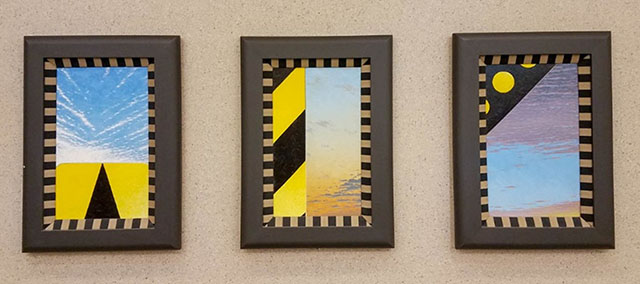
GUIDE SUITE, 2000, Oil on panel and, fabric on wood
Dan Bruggeman
Saint Paul, Minnesota
Dan Bruggeman's series of three paintings addresses the form and content of a road sign, and how they function to assist the traveler to navigate from one point to the next.
Looking to the historical relationship between art and travel for this MnDOT project, Bruggeman investigated early 19th century landscape artists such as George Catlin and Karl Bodmer who traveled the continent to document the wilderness without the benefit of road signs. The artist became fascinated with the idea of combining the aesthetics of road signs and a traditional-looking landscape painting.
According to Bruggeman, road signs, like graphs, diagrams, and charts, rely on recognizable and easily understood symbols and shapes to quickly convey complex information. Such signs have been reduced to recognizable shapes, color and pattern and engage the traveler on a cognitive level. Thus, in Guide Suite, Bruggeman has combined a beautiful sunset sky with the geometry of a well-placed sign fragment to create an abstract composition that allows the viewer to consider interpretation of both art and travel.
Dan Bruggeman holds a B.F.A. from University of Nebraska and an M.F.A. from Hunter College, New York City. His work has been exhibited widely and can be found in numerous private and corporate collections including those of the Minnesota Historical Society, St. Paul Companies, 3M, and IDS/American Express Financial Services.
Guide Suite was made possible through Minnesota Percent for Art in Public Places, a program sponsored by the Minnesota State Arts Board and the Department of Administration, with support for this project from the Minnesota Department of Transportation, Central Office Building, Saint Paul, Minnesota.
Irve Dell, CAR CUBE, 2004, St. Paul, MN, Ground Floor Lobby
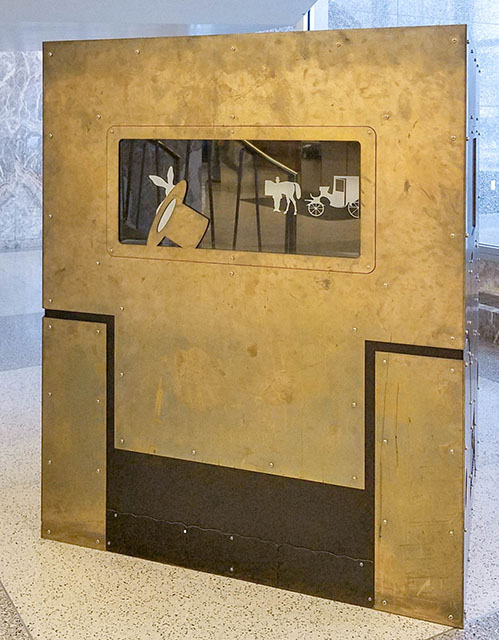 Car Cube by Irve Dell
Car Cube by Irve Dell
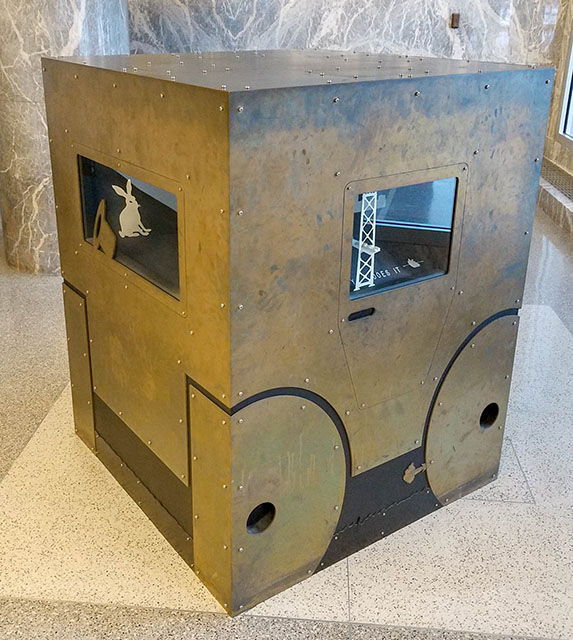 Car Cube by Irve Dell
Car Cube by Irve Dell
CAR CUBE, 2004 Bronze, steel, glass, wood, flannel, styrene
lrve Dell
St. Paul, Minnesota
Inspired by the visual tradition of information display and kiosks with letterboards, Car Cube combines a kiosk like object with a car shape and uses the resulting form to present visual narratives about the car and vehicular travel in general. The intention was to create a centrally placed single object that evokes thinking and memories that connect themes of travel, speed, transportation, the car, the road, and nature.
The bulk of the sculpture is sheet bronze fastened to a black powder-coated steel frame. The glass in the windows is tempered safety glass. The diorama boxes are lined with black flannel and the images are water-jet cut from white styrene plastic. Pushing and holding the silver button below the front window activates the flashing red light on top of the squad car in the diorama. Over time, the bronze will achieve a natural honey-brown patina caused by oxidation and human hands.
The project was possible through Minnesota Percent for Art in Public Places, which is sponsored by the Minnesota State Arts Board and the Department of Administration, with support from the Minnesota Department of Transportation.
Ken Moylan, STONE ARCH BRIDGE, 2000, Minneapolis, MN, Ground Floor South of Elevator Lobby
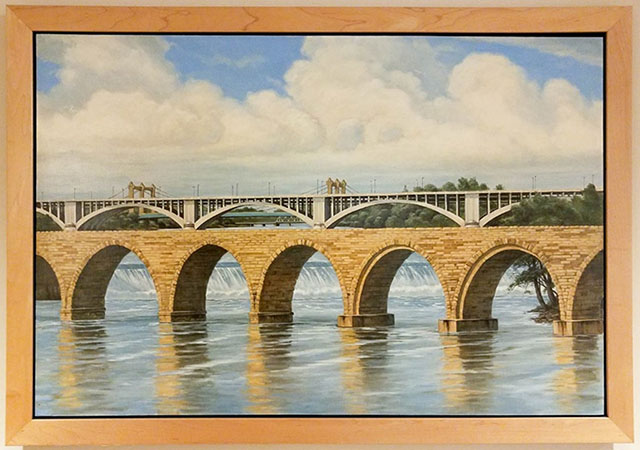 Stone Arch Bridge by Ken Moylan
Stone Arch Bridge by Ken Moylan
STONE ARCH BRIDGE, 2000, Oil on panel
Ken Moylan
Minneapolis, Minnesota
In Stone Arch Bridge, Ken Moylan has painted the Mississippi River at St. Anthony Falls in downtown Minneapolis. The view is one of looking up river at the historic James J. Hill Bridge (Stone Arch Bridge) with the Third Avenue and Hennepin Avenue bridges in the background. These landmark bridges and others, as well as the Mississippi River itself, represent modes of transportation that established Minneapolis as a center of commerce and culture. Today, these bridges still remain as vital links between downtown Minneapolis and the thriving communities north of the city.
Moylan's realist style perfectly captures both the functionality and romance of these varied transportation systems. The monumentality and curved structural forms are echoed in the billowing clouds overhead. One senses not only the significance of these bridges to daily life in Minneapolis, but also the larger Mississippi River landscape.
Ken Moylan has his B.F.A. from the Minneapolis College of Art and Design. His work has been exhibited widely and can be found in numerous private, corporate and museum collections including those of The Minneapolis Institute of Arts, The Albrecht Kemper Museum of Art, Tweed Museum, McKnight Foundation, General Mills, McDonald's Corporation, Arthur Andersen & Company and Piper Jaffray.
Stone Arch Bridge was made possible through Minnesota Percent for Art in Public Places, a program sponsored by the Minnesota State Arts Board and the Department of Administration, with support for this project from the Minnesota Department of Transportation, Central Office Building, Saint Paul, Minnesota.
Mark E. Jensen, ITASCA STATE PARK, 1995, Minneapolis, MN, Ground Floor Lobby West
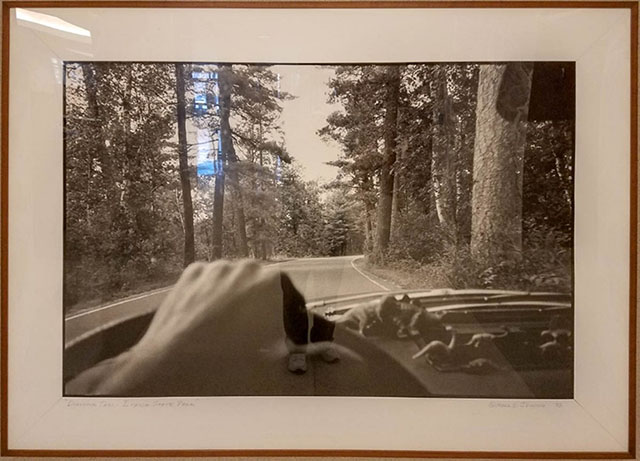
ITASCA STATE PARK, 1995, Silverprint photograph
Mark E. Jensen
Minneapolis, Minnesota
Itasca State Park is from a series of pictures entitled Dinosaur Taxi-On the Road. The photographs were taken from behind the wheel of Jensen's twenty-year-old automobile, the "dinosaur taxi." Often the view through the windshield features a composition including toy dinosaurs arranged on the dashboard as well as a landscape of city streets, country roads, or superhighways.
Jensen has lived in Minnesota most of his life, and this picture was taken on his first visit to Itasca State Park, the source of the Mississippi River.
The artwork was purchased in 1996 by Minnesota Percent for Art in Public Places, a program sponsored by the Minnesota State Arts Board and the Department of Administration, with support for this project from the Minnesota Department of Transportation.
Helena Hernmarck, THE FOUR ELEMENTS, 1996, Ridgefield, CT, MnDOT Cafeteria Ground Floor
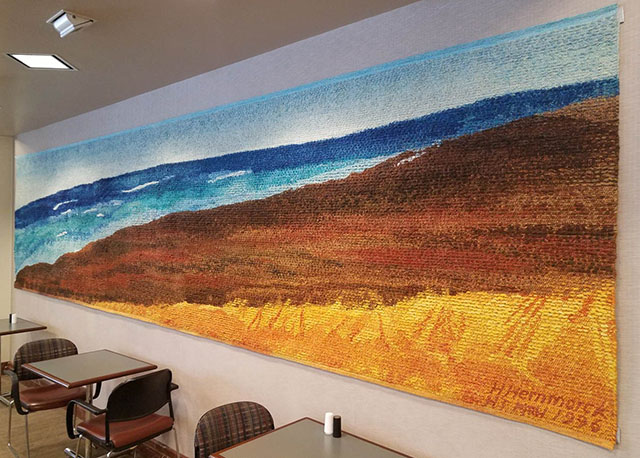 The Four Elements by Helena Hernmarck
The Four Elements by Helena Hernmarck
THE FOUR ELEMENTS, 1996 Tapestry in wool, linen, and dacron fish line
Helena Hernmarck
Ridgefield, Connecticut
Helena Hernmarck has chosen to use the concept of the four elements-fire, air, earth, and water-to refer to the subject of transportation. According to the dictionary, transportation is defined as powered motion through the air, over the sea, and over the land.
The Midwest location inspired Hernmarck to design a work with strong horizontal lines. To create a sense of spaciousness, the artist has arranged the composition as a landscape. With a few simple strokes, the horizon line proceeds from left to right, at a slight angle to evoke speed. Capturing the impression of speed during the slow process of weaving the tapestry was one of Hernmarck's challenges.
Hernmarck has used the dominant horizontal composition of the artwork to overcome the visual interruptions imposed by columns that partially block the view of the wall. This composition enables the viewer to experience the work as continuous from any position in the room.
The vibrant color scheme of the tapestry contributes a warm glow to the room throughout the seasons. In addition to 500 colors of linen and wool yarn, Hernmarck features the bright orange and green of dacron fly fishing line in the warp.
Hernmarck's work was honored for excellence by the American Institute of Architects in 1973, and she became a Fellow of the American Craft Council in 1996. Her work is in the permanent collections of several major museums, including the Museum of Modern Art, the Metropolitan Museum of Art and the American Craft Museum, all in New York, NY; the Art Institute of Chicago; the Los Angeles County Museum; and the Minneapolis Institute of Arts.
Assisting Hernmarck in the production of the tapestry were Hanna Tsao and Molly Doe Wensberg.
The artwork was commissioned through Minnesota Percent for Art in Public Places, a program sponsored by the Minnesota State Arts Board and the Department of Administration, with support for this project from the Minnesota Department of Transportation.
Mike Lynch, PIONEER STEEL ELEVATOR AND MOONLIGHT, 2000, Minneapolis, MN, First floor Entry Lobby
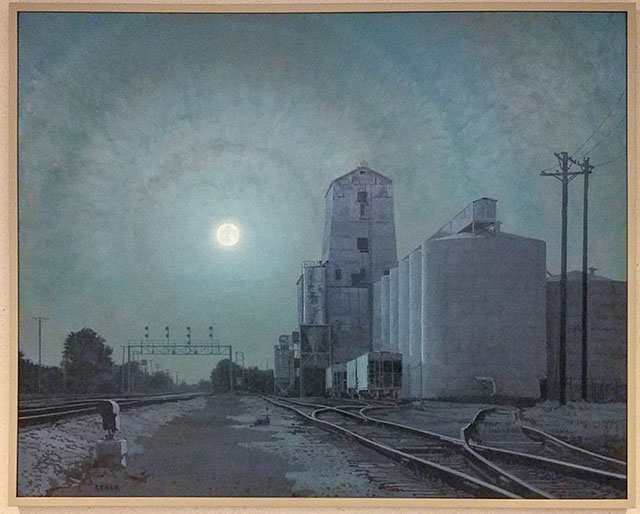 Pioneer Steel Elevator and Moonlight by Mike Lynch
Pioneer Steel Elevator and Moonlight by Mike Lynch
PIONEER STEEL ELEVATOR AND MOONLIGHT, 2000, Oil on Linen
Mike Lynch
Minneapolis, Minnesota
Grain elevators and railroad systems have played an important role in the agricultural economy of the state of Minnesota. They are also important subject matter for Mike Lynch who has depicted them frequently in his realist style paintings, prints and drawings reminiscent of the American Regionalism era of the 1920s and '30s.
The great Pioneer Steel Elevator stood for many years alongside the Burlington Northern main line railroad through Northeast Minneapolis. The majority of grain elevator bins in Minnesota were constructed from reinforced concrete, but some bins with very large diameters were also built from steel.
Since 1980, Lynch has painted several views of the Pioneer Steel Elevator from various spots along the Burlington Northern tracks, including some under a full moon. Lynch painted this particular work in his studio from his sketches and photographs. To create the mysterious, atmospheric work, he used titanium white, spinel black, cerulean blue, green earth, and. also red and yellow ochres from the Mesabi Iron Range.
Lynch was born in Hibbing, Minnesota in 1938. He studied painting and drawing at the Grand Marais Art Colony, the Minneapolis College of Art, and the Rijksmuseum in Amsterdam. His work is found in numerous collections including those of The Minneapolis Institute of Arts, The Minnesota Historical Society, 3M, and the St. Paul Companies.
Pioneer Steel Elevator and Moonlight was made possible through Minnesota Percent for Art in Public Places, a program sponsored by the Minnesota State Arts Board and the Department of Administration, with support for this project from the Minnesota Department of Transportation, Central Office Building, Saint Paul, Minnesota.
David Knowlton, AFTERNOON HIAWATHA, 2000, Eau Claire, WI, First Floor South of Elevator Lobby
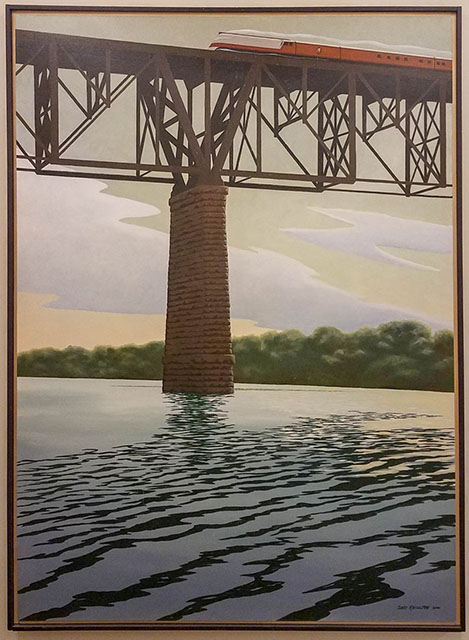 Afternoon Hiawatha by David Knowlton
Afternoon Hiawatha by David Knowlton
AFTERNOON HIAWATHA, 2000, Oil on Canvas
David Knowlton
Eau Claire, Wisconsin
David Knowlton's lyrical but structured painting, Afternoon Hiawatha, shows the famed train crossing the Short Line Bridge, a Minneapolis landmark that spans the Mississippi River between the Franklin Avenue and Lake Street bridges. Knowlton's work shows the red and white Afternoon Hiawatha on its way to Saint Paul, just before taking on passengers during a forty-three minute stop at Saint Paul's Union Station.
In May of 1935, the Milwaukee Railroad inaugurated the Twin Cities Hiawatha train. The Hiawatha line competed with the Burlington Northern's Zephyr routes and the Chicago & Northwestern's 400 line for passengers traveling between Chicago and the Twin Cities. The Hiawatha made the 410 mile trip in six and one-half hours, at times reaching speeds over 100 miles per hour. The Milwaukee Railroad called them "Speedliners."
Horton has painted a compositionally dynamic painting placing the viewer at water’s edge, dramatically looking up at the speeding t rain. The towering pylon and steel girders effectively contrast with the dwindling daylight, soft green trees and broad expanse of water. The streamline shape of the train adds to the sense of speed and travel.
David Knowlton studied at the University of Wisconsin in Milwaukee and Eau Claire. His work can be found in private and corporate collections in Minnesota, Wisconsin, Colorado, and New Mexico, among others.
Afternoon Hiawatha was made possible through Minnesota Percent for Art in Public Places, a program sponsored by the Minnesota State Arts Board and the Department of Administration, with support for this project from the Minnesota Department of Transportation, Central Office Building, Saint Paul, Minnesota.
Mark Horton, TURNING BUS ON BUSY STREET, 2000, Eau Claire, WI, First Floor Mn.IT Lobby
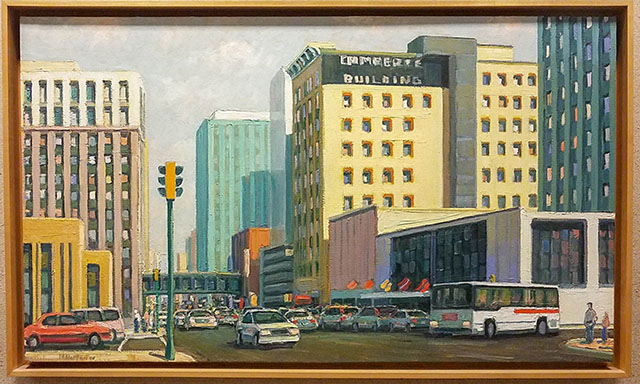 Turning Bus on Busy Street by Mark Horton
Turning Bus on Busy Street by Mark Horton
Turning Bus on Busy Street, 2000, Oil on Canvas
Mark Horton
Eau Claire, Wisconsin
Mark Horton has created a series of three paintings that depict the wide variety of transportation systems found in the city of Saint Paul, Minnesota. While we typically think of our state transportation system as roads and highways, in addition to busy city streets filled with cars and buses, it includes the Mississippi River with its soaring bridges, dark steel railroad tracks and air space. Each painting began as a thumbnail sketch that Horton expanded into fully realized paintings.
For Horton, Bridges Over River reflects the importance of highways and waterways serving as connecting links between cities and the greater world. City On Bluffs suggests the dependence of the city upon transportation to remain vital. Turning Bus On Busy Street focuses on transportation within the city at street level.
Horton paints in a realistic but gestural style that captures the mood and atmosphere of his subject matter. Strokes of high-keyed color and his myriad of forms animate his compositions giving the viewer a sense of the activity and beauty that defines Saint Paul.
Mark Horton holds B.A. and J.D. degrees from the University of Minnesota, Minneapolis. After practicing law, he turned to painting as a career. His work has been exhibited in the Midwest and can be found in numerous private and corporate collections.
Bridges Over River, City On Bluffs, Turning Bus On Busy Street were made possible through Minnesota Percent for Art in Public Places, a program sponsored by the Minnesota State Arts Board and the Department of Administration, with support for this project from the Minnesota Department of Transportation, Central Office Building, Saint Paul, Minnesota.
Mark Horton, CITY ON BLUFFS, 2000, Eau Claire, WI, First Floor Mn.IT Lobby
 City on Bluffs by Mark Horton
City on Bluffs by Mark Horton
See Mark Horton, Turning Bus on Busy Street above for further details.
Mark Horton, Bridges Over River, 2000, Eau Claire, WI, First Floor Mn.IT Lobby
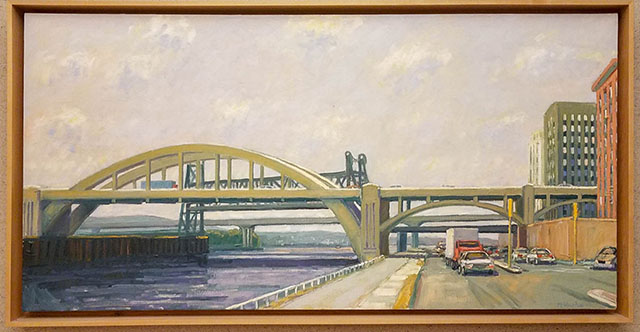 Bridges Over River by Mark Horton
Bridges Over River by Mark Horton
See Mark Horton, Turning Bus on Busy Street above for further details.
Steve R. Jensen, LAKE DANCERS, 1997, Seattle, WA, First Floor Main Lobby
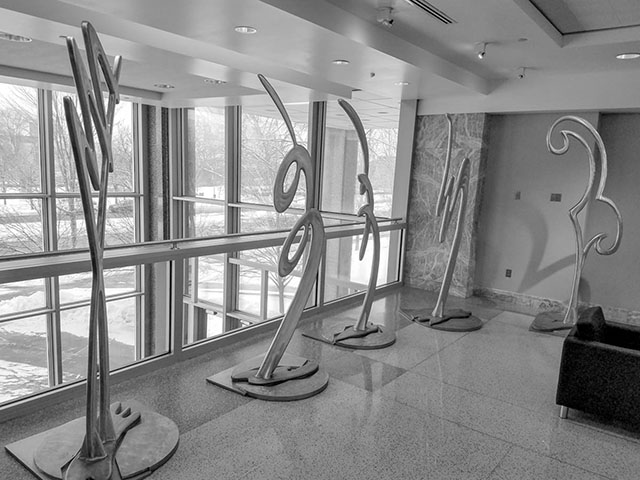 Lake Dancers by Steve R. Jensen
Lake Dancers by Steve R. Jensen
LAKE DANCERS, 1997, Aluminum
Steve R. Jensen
Seattle, Washington
Commissioned under the Minnesota Percent for the Art in Public Places.
No other information was provided.
Artist unknown, (Terrazzo mural depicting surveyor, draftsman, and two construction workers), First Floor Main Lobby
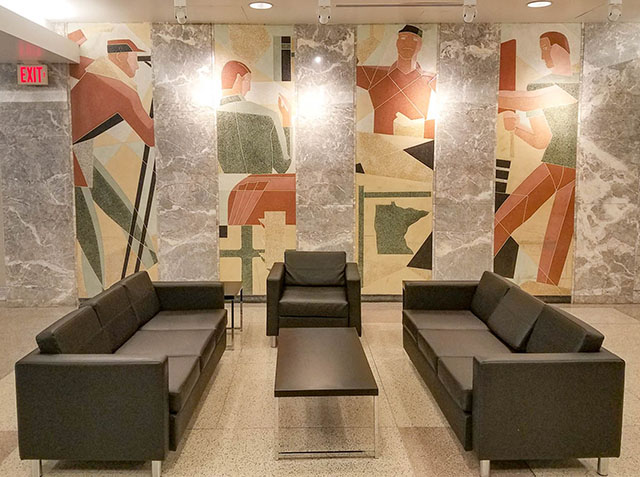 Transportation Building Mural in Terrazzo
Transportation Building Mural in Terrazzo
William E. Murray, SWING BRIDGE, 1997, St. Paul, MN, Second Floor Elevator Lobby
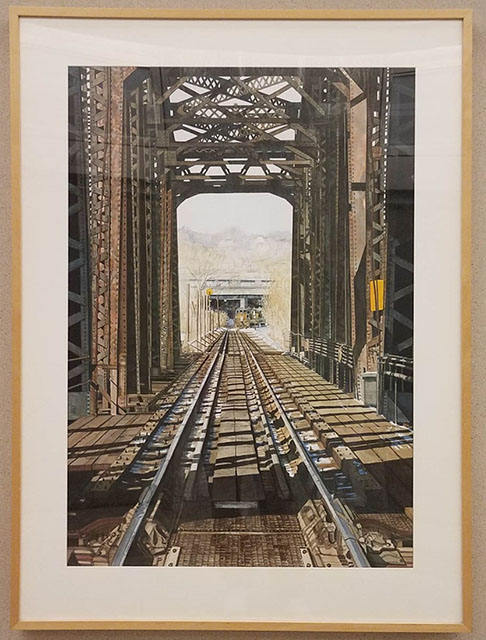 Swing Bridge by William E. Murray
Swing Bridge by William E. Murray
SWING BRIDGE, SAINT PAUL, 1997, Watercolor
William E. Murray
Saint Paul, Minnesota
Nothing captures the imagination or mesmerizes the human spirit like the long, haunting wail of a train whistle. The rhythm of train wheels moving along seemingly endless tracks has long symbolized the birth of modern transportation, and the taming of the American frontier.
Trains have fascinated Murray since he was a child. He remarks, "they are inseparable from the infrastructure which supports them-ribbons of rails disappearing into the horizon; the symmetrical cross-hatching of steel beams on bridges spanning rivers and valleys; the balanced order of freight cars; and the proportioned simplicity of a worn caboose. As an artist, these intrigue me."
In this scene of the Lilydale Swing Bridge, Murray found the contrast of rigid steel and iron with the elusiveness of light and shadow to be uniquely compelling.
Watercolor is one of the most challenging artistic mediums because it requires an extreme level of technical knowledge and skill. Painting the intricate detail of this scene presented a particular challenge for the artist. To Murray, the ability to manipulate imagination, and commit it to a tangible state of reality, is a form of magic.
The painting was commissioned in 1997 through Minnesota Percent for Art in Public Places, a program sponsored by the Minnesota State Arts Board and the Department of Administration, with support for this project from the Minnesota Department of Transportation.
Martha Wittstruck, SERIES OF CERAMIC PLATTERS, 1997, Lakeville, MN, Third Floor Elevator Lobby
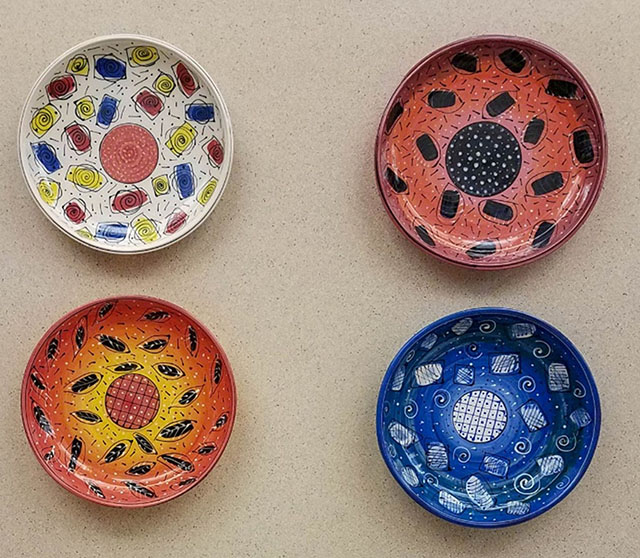 Series of Ceramic Platters by Martha Wittstruck
Series of Ceramic Platters by Martha Wittstruck
SERIES OF CERAMIC PLATTERS, 1997, Underglaze decoration on clay
Martha Wittstruck
Lakeville, Minnesota
Color and clay are Wittstruck's inspiration. The soft, expressive clay that is thrown on a wheel is the starting point. After the pieces are dry, Wittstruck decorates them with colored underglazes. She prefers to paint the glazes in a spontaneous, free-form manner, and thinks of the colors as dancing across the surface of the work.
The platter forms, which appear to be spinning because they have been thrown on a wheel, also seem to refer to tires, providing a light-hearted reference to the subject of transportation.
The artwork was commissioned in 1997 through Minnesota Percent for Art in Public Places, a program sponsored by the Minnesota State Arts Board and the Department of Administration, with support for this project from the Minnesota Department of Transportation.
Rod Massey, FREEWAY SCENE, November 1997, Minneapolis, MN, Fourth Floor Elevator Lobby
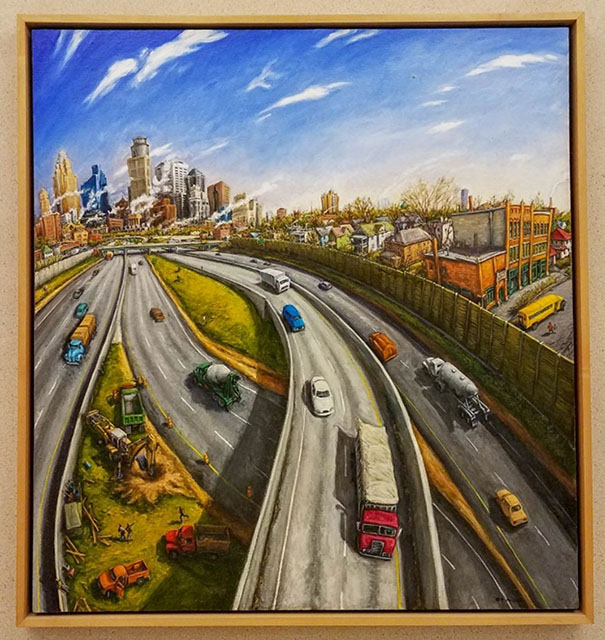 Freeway Scene by Rod Massey
Freeway Scene by Rod Massey
FREEWAY SCENE, NOVEMBER 1997, Oil on canvas
Rod Massey
Minneapolis, Minnesota
This bird's eye view of freeway traffic and the city skyline of Minneapolis conveys the presence and impact of transportation on our urban environment. The vehicles seem to be moving at great speed, and even the buildings seem in a hurry. Massey's animated painting style captures the intense activity of everyday life in both the city's residential and commercial quarters.
Local art critic Doug Hanson has written, "Massey's neighborhood houses seem to bloom up and out like flowers in a vase. His buildings have a jumpiness to them that brings to mind the work of Wanda Gag, the Minnesota-born artist whose lithographs achieved for her a national reputation in the twenties and thirties. Like Gag, Massey has the ability to bestow an aura of life upon inanimate objects."
The artwork was commissioned in 1997 through Minnesota Percent for Art in Public Places, a program sponsored by the Minnesota State Arts Board and the Department of Administration, with support for this project from the Minnesota Department of Transportation.
Steven Woodward, APPLY YOUR EYE (FOR JAMES JOYCE), 1992, Minneapolis, MN, Fifth Floor Elevator Lobby
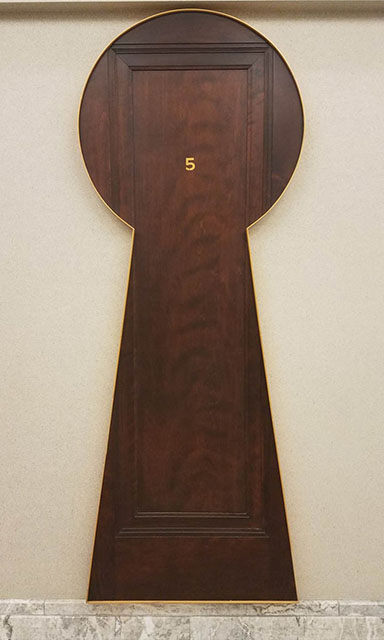 Apply Your Eye (For James Joyce) by Steven Woodward
Apply Your Eye (For James Joyce) by Steven Woodward
APPLY YOUR EYE (FOR JAMES JOYCE), 1992, Wood wall relief
Steven Woodward
Minneapolis, Minnesota
The scale and geometry of this form, a circle resting atop a trapezoid, is commonly recognized as a keyhole. However, Woodward's interpretation has turned the meaning of a keyhole inside out-rather than a small opening into which a key fits, the whole door has become the keyhole.
The obvious metaphor for this sculpture is voyeurism and the novel, Ulysses, by James Joyce, as indicated by the sculpture's title. However, this evocative sculptural form suggests other references. Woodward was also inspired by the Moorish architecture of the Alhambra in Granada, Spain, and remarks, "I chose the number five from the twelve doors I had available, as a reference to Islamic legend of the hand of Fatima used as a charm to ward off the evil eye."
The artwork was purchased in 1996 by Minnesota Percent for Art in Public Places, a program sponsored by the Minnesota State Arts Board and the Department of Administration, with support for this project from the Minnesota Department of Transportation.
Christopher Faust, BN COWLING, MIDWAY ELEVATOR, DISTRICT, Minneapolis, Saint Paul, MN, Sixth Floor Elevator Lobby
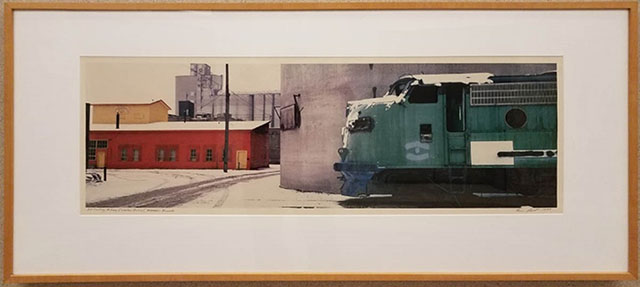 BN Cowling by Christopher Faust
BN Cowling by Christopher Faust
BN COWLING, MIDWAY ELEVATOR, 1989, C Print from color negative
Christopher Faust
Saint Paul, Minnesota
Faust is concerned with how humans affect and dominate the natural landscape, creating a "cultural" landscape that they constantly revise to meet their needs. This image captures a quiet moment in the Midway Elevator district on a wintry day in 1989. A week later, the Cowling had moved, and the whole scene changed. Within a year, the red and yellow building had been sold and painted gray. "I see humans as a subset of nature," Faust comments, "but we have such a limited understanding of nature and the impact of our actions. I have always found the tension between nature and human activity to be a fertile ground for image-making."
The artwork was purchased in 1996 by Minnesota Percent for Art in Public Places, a program sponsored by the Minnesota State Arts Board and the Department of Administration, with support for this project from the Minnesota Department of Transportation.
Bruce McClain, DELAUNAY'S GUEST, 1993, Saint Peter, MN, Seventh Floor Elevator Lobby
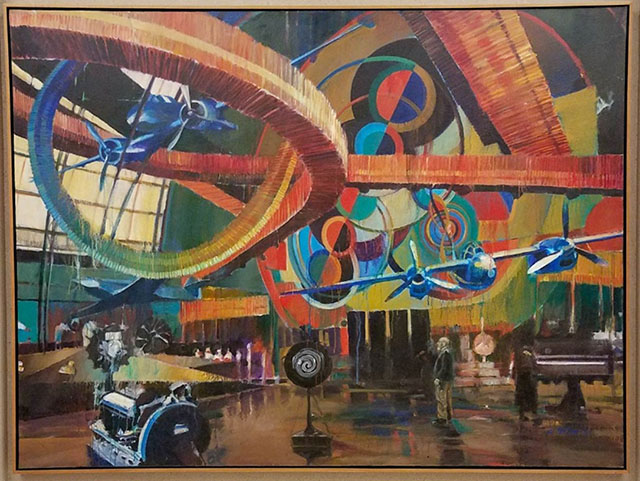 Delaunay's Guest by Bruce McClain
Delaunay's Guest by Bruce McClain
DELAUNAY'S GUEST, 1993, Acrylic on canvas painting
Bruce McClain
Saint Peter, Minnesota
Delaunay's Guest is inspired by a black and white photograph of the Palais de l'Air (Palace of Aviation) at the 1937 International Exposition-Arts and Technology held in Paris. Artists Robert and Sonia Delaunay had designed an exhibit that portrayed a sympathetic relationship between the modern innovations of aviation and abstract art. In their large mural, the artists experimented with color and used shapes of concentric rings or disks that suggest a propeller spinning at high speed. They also entwined a suspended aircraft with brightly colored, pleated metal ribbons that appeared to be frozen vapor trails.
McClain has improvised the colors in this painting, using the palette the Delaunay’s may have used in the original exhibition. He has also introduced a figure representing artist Henri Matisse as a guest visiting the exhibit. Matisse is the twentieth-century artist who most influenced the use of color freeing its role from only imitating external reality. Matisse first experienced flying from London to Paris in 1937, and he later spoke of this event in the same way he referred to an art experience: "This is where we should come when we need to be uplifted."
McClain has been interested in both art and aviation since childhood, and he often incorporates aviation images into his paintings. He remarks, "I can understand the Delaunays' sympathy for integrating modem machines with modern art. As a child growing up in rural Wisconsin, the sight of aircraft flying overhead gave me an imaginary connection to far-off, exotic places and experiences. That imagination became tangible for me through making art. In Delaunay's Guest, I have attempted to revisit and revise an historical event through the act of painting."
The artwork was purchased in 1996 by Minnesota Percent for Art in Public Places, a program sponsored by the Minnesota State Arts Board and the Department of Administration, with support for this project from the Minnesota Department of Transportation.
Donald Zwernik, MIDWESTERN MOSAIC, 1992, Minnetonka, MN, Eighth Floor Elevator Lobby
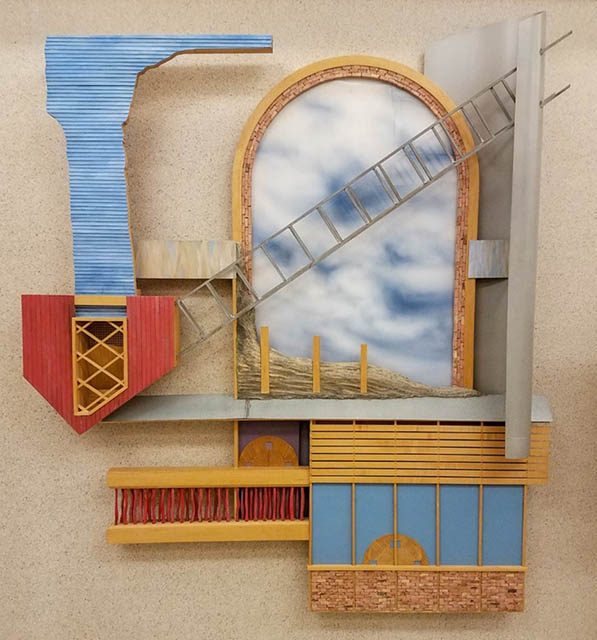 Midwestern Mosaic by Donald Zwernik
Midwestern Mosaic by Donald Zwernik
MIDWESTERN MOSAIC, 1992, Wood wall relief
Donald Zwernik
Minnetonka, Minnesota
Midwestern Mosaic portrays a collection of memory fragments from Zwernik's early life on a Wisconsin dairy farm. Forms that symbolize farm buildings and structures are assembled to create a fluid and balanced composition.
The center portion of the wall relief contrasts dark plowed earth with a large bright expanse of sky. A horizontal linear steel structure cuts through the sky and leads our eye to the hopper of a harvesting machine in the lower left corner of the composition. Within the hopper, a screen-like grid separates the grain from the chaff. The slatted ribs of the adjacent corn crib move our eyes across the composition and the horizontal line of the galvanized metal roof directs us back to the grain hopper.
The grain hopper and the lap-sided wall fragment above it are rendered in materials that are characteristic of farm building exteriors. Zwernik generally uses naturalistic colors throughout the piece, with the addition of red, which is a typical barn color, and purple, to provide emphasis and balance. At the bottom of the wall relief, peeled twigs painted red represent a section of tree trunks in a heavily wooded pasture.
The artwork was purchased in 1996 by Minnesota Percent for Art in Public Places, a program sponsored by the Minnesota State Arts Board and the Department of Administration, with support for this project from the Minnesota Department of Transportation.
